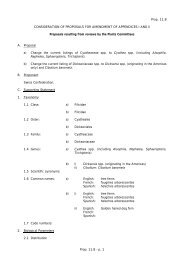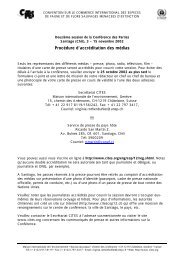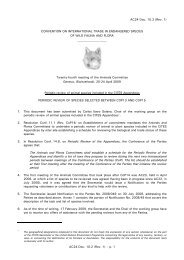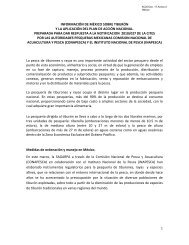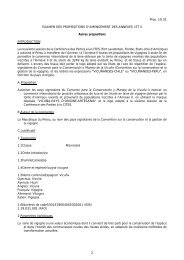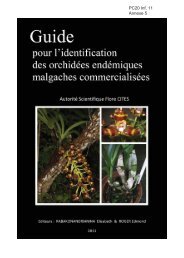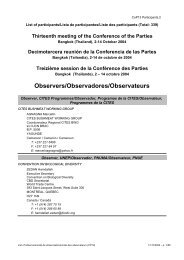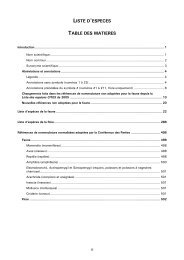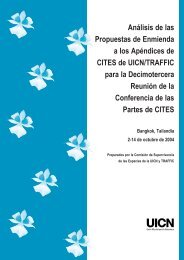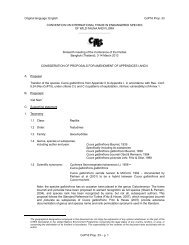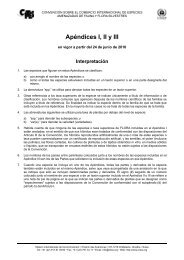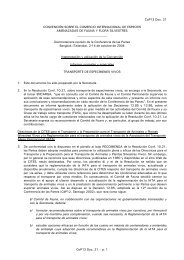Lamna nasus - Cites
Lamna nasus - Cites
Lamna nasus - Cites
Create successful ePaper yourself
Turn your PDF publications into a flip-book with our unique Google optimized e-Paper software.
Draft Proposal to list <strong>Lamna</strong> <strong>nasus</strong> in Appendix II - prepared by Germany in January 2012<br />
11. Additional remarks<br />
11.1 CITES Provisions under Article IV, paragraphs 6 and 7: Introduction from the sea<br />
It is unclear whether introduction from the sea will be a significant issue for this species. Most target fisheries,<br />
even on the shelf edge, have been recorded inside EEZs. Pelagic Japanese, Korean and Taiwanese vessels,<br />
however, take porbeagle bycatch on the high seas, estimates for Japan ranging from 15t to 280t annually<br />
during 2000–2002 (DFO 2005b). A CITES Appendix II listing would require introductions from the sea to be<br />
accompanied by a non-detriment finding. They would have to be taken from a sustainably exploited high seas<br />
fishery, requiring management action by the appropriate Regional Fisheries Management Organisation. FAO<br />
(2010) considered that regulation of international trade through listing in CITES Appendix II could strengthen<br />
national efforts to keep harvesting for trade commensurate with stock rebuilding plans and improve the<br />
control of high seas catches through the use of certificates of introduction from the sea accompanied by non<br />
detriment findings.<br />
11.2 Implementation issues<br />
11.2.1 Scientific Authority<br />
It would be most appropriate for the Scientific Authority for this species to be advised by a fisheries expert.<br />
11.2.2 Identification of products in trade<br />
It will be important to develop species-specific commodity codes and identification guides for the meat and<br />
fins of this species. L. <strong>nasus</strong> meat, the product most commonly traded, is one of the highest priced shark meats<br />
in trade and often identified by name. The dorsal fin (with skin on) has a characteristic white rear free edge<br />
and a generic guide to the identification of shark fins is available (Deynat2010). Several research groups have<br />
developed species-specific primers and highly efficient multiplex PCR (Polymerase Chain Reaction)<br />
screening assay for L. <strong>nasus</strong>, capable of distinguishing between Southern and Northern Hemisphere stocks<br />
(e.g. Shivji et al. 2002; Pade et al. 2006; Testerman et al. 2007). Cost per sample processed starts from<br />
US$20–60, depending upon condition of sample, less for large numbers. Turn-around time is in the region of<br />
2–7 days from receipt of sample, depending upon urgency. These tests are available and may be used to<br />
confirm identification and product origin for enforcement purposes.<br />
11.2.3 Non-detriment findings<br />
CITES AC22 Doc. 17.2 provides first considerations on non-detriment findings for shark species. The<br />
Spanish Scientific Authority (García-Núñez 2008) reviewed the management measures and fishing<br />
restrictions established by international organisations related to the conservation and sustainable use of sharks,<br />
offering some guidelines and a guide of useful resources. It also adapted to elasmobranch species the checklist<br />
prepared for making NDF by IUCN (Rosser & Haywood 2002). Similarly, the outcome of the Expert<br />
Workshop on Non-Detriment Findings (Anonymous 2008) points to the information considered essential for<br />
making NDF for sharks and other fish species, and also proposes logical steps to be taken when facing this<br />
task.<br />
Management for L. <strong>nasus</strong> would ideally be based upon stock assessments and scientific advice to allow stock<br />
rebuilding (where necessary) and ensure sustainable fisheries (e.g. through quotas or technical measures,<br />
including closed areas, size limits and the release of live bycatch). This is standard fisheries management<br />
practice – albeit currently not widely applied for this species. Other States wishing to export L. <strong>nasus</strong> products<br />
would also need to develop and implement sustainable fisheries management plans if NDFs are to be<br />
declared, and would need to ensure that all States fishing the same stocks implement and enforce equally<br />
precautionary conservation and management measures.<br />
12. References (see Annex 5)<br />
Page 14 of 14<br />
AC26 Doc. 26.2, Annex 1 – p. 14<br />
AC26 Doc. 26.2<br />
Annex / Anexo /Annexe<br />
(English only / únicamente en inglés / seulement en anglais)




